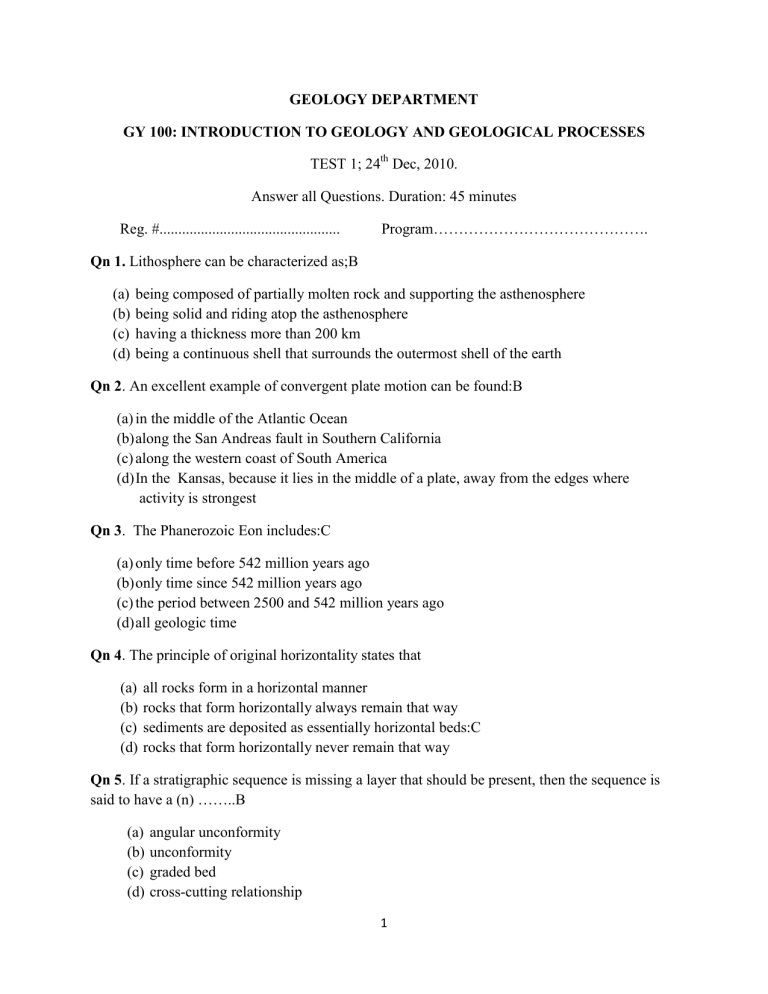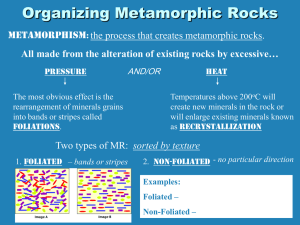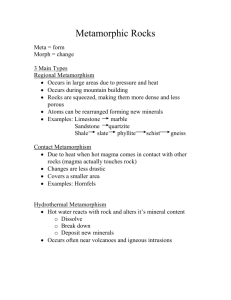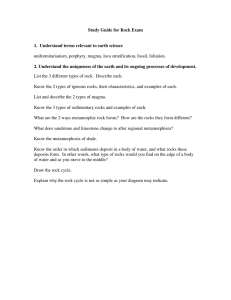Geology Test 1: Introduction to Geology

GEOLOGY DEPARTMENT
GY 100: INTRODUCTION TO GEOLOGY AND GEOLOGICAL PROCESSES
TEST 1; 24 th
Dec, 2010.
Answer all Questions. Duration: 45 minutes
Reg. #................................................ Program…………………………………….
Qn 1.
Lithosphere can be characterized as;B
(a) being composed of partially molten rock and supporting the asthenosphere
(b) being solid and riding atop the asthenosphere
(c) having a thickness more than 200 km
(d) being a continuous shell that surrounds the outermost shell of the earth
Qn 2 . An excellent example of convergent plate motion can be found:B
(a) in the middle of the Atlantic Ocean
(b) along the San Andreas fault in Southern California
(c) along the western coast of South America
(d) In the Kansas, because it lies in the middle of a plate, away from the edges where activity is strongest
Qn 3 . The Phanerozoic Eon includes:C
(a) only time before 542 million years ago
(b) only time since 542 million years ago
(c) the period between 2500 and 542 million years ago
(d) all geologic time
Qn 4 . The principle of original horizontality states that
(a) all rocks form in a horizontal manner
(b) rocks that form horizontally always remain that way
(c) sediments are deposited as essentially horizontal beds:C
(d) rocks that form horizontally never remain that way
Qn 5 . If a stratigraphic sequence is missing a layer that should be present, then the sequence is said to have a (n) ……..B
(a) angular unconformity
(b) unconformity
(c) graded bed
(d) cross-cutting relationship
1
Qn 6.
Magma bodies tend to rise in the crust because they:D
(a) are large and need space to grow
(b) contain less dense minerals
(c) are hot, which has lowered their density
(d) are being forced up by the subduction processe
Qn 7 . For each of the rock types given, select a corresponding term from each of the two lists to the right. e.g. (1) I, b granite
(2)…II…, …A……basalt I. felsic a. fine grained
(3)…III…, B……diorite II. mafic b. coarse grained
(4)…I…, …A……rhyolite III. Intermediate c. glassy
(5)…I…, …C……pumice IV. not applicable
(6)…II…, …B……gabbro
7)…III…, …A……andesite
Qn 8 . Basalt and Gabbro have the same……..but different……B…
(a) cooling history, temperature of formation
(b) compositions, textures
(c) textures, compositions
(d) amount of orthoclase, amount of ferromagnesians
Qn 9 . Which of the following pairs of minerals would not be found together in an igneous rock?B
(a) olivine and pyroxene
(b) muscovite and quartz
(c) quartz and olivine
(d) amphibole and biotite
Qn 10.
Metamorphic rocks are those which have;B
(a) been heated to the melting point of their constituent minerals
(b) been changed by high temperatures and pressure
(c) been formed at earth’s surface
(d) undergone great deal of erosion
2
Qn 11 . The progressive metamorphism of shale will produce which of the following sequence of rocks?C
(a) Schist- Phyllite- Slate
(b) Migmatite- gneiss, granite
(c) Slate- Phyllite- Schist
(d) Claystone- Sandstone- Mudstone
(e) Phyllite- Slate- Schist
Qn 12 . Blueschist- facies metamorphic rocks are characteristic of;B
(a) Contact metamorphism
(b) Subduction zone related metamorphism
(c) Regional metamorphism
(d) Shock metamorphism
Qn 13.
Rocks that are ductile tend to be associated with
(a) Faults
(b) Joints
(c) Folds
(d) Strike –slip motion
Qn 14 . The formation of reverse faults is due to;A
(a) Tensional forces
(b) Compressional forces
(c) Brittle, nonelastic rock
(d) Soft, malleable rock
Qn 15.
Which of the following types of faults is marked by the downward movement of the hanging wall block relative to the foot wall block?D
(a) Reverse fault
(b) Thrust fault
(c) Normal fault
(d) Dip- slip fault
3




